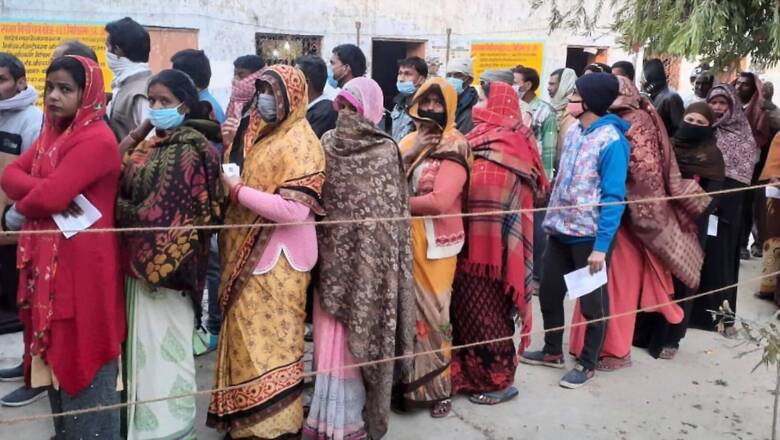
views
Five long weeks of election campaigning do not take a toll on just politicians, but also journalists. Covering an election amidst a pandemic, in states where people think Covid-19 is over and face masks are history, is another compounding challenge.
But elections are all about meeting people, knowing if the situation on the ground has changed since the last polls and experiencing the changing polity.
Here are some takeaways from Ground Zero:
Finding Candidates
A good idea in elections to assess ground realities is avoiding the big public meetings of star campaigners which are invariably full of supporters of the party concerned and are usually live-streamed on social platforms. Instead, go find the candidates during their village-to-village rounds. This makes one gauge the public mood better, witness their unfiltered response to a particular candidate and one can invariably also find candidates facing a litany of complaints, much to their embarrassment. But first, how to get there?
Finding a candidate in the constituency is a tough job as the contender leaves for campaigning from the district centre to deep inside villages by the time one reaches there. “Netaji toh ab kshetra mein hain,” is a response one would get by calling up the candidate, with the phone being answered by the aide. Requests for live location are scoffed at, given there is hardly any network in the villages. One may get to the correct village to only know the candidate has left, and the chase begins again.
Since one must find both leading candidates in a high-profile seat for balance and a fair assessment, this may consume almost a full day. The effort may be worth it though as apart from the candidates, one gets to visit multiple villages and speak to a cross-section of people awaiting the candidate’s arrival or absorbing his or her speech. In the process, one will be surprised how big an assembly constituency is, involving travel of even an hour or more from the district centre to get to the village.
Perhaps, the EC can from next time make it incumbent upon all candidates to share their live locations from a designated phone during campaigning, making the task easier for not just the ECI officials but also journalists to track them!
Don’t Trust Google Maps, ask People
“The state minister is coming to Gora village, come there,” an aide says. One enters Gora on Google Maps and it is about 30 minutes from the district centre. A bumpy ride gets one there to find it is the wrong ‘Gora’ village, and the correct one is in fact in the opposite direction, an hour away. Or one goes finding Islampur village in a district and is told there are two — Bada Islampur and Chota Islampur, 20 minutes apart. Yes, there are multiple villages by same name in a district!
So, always ask locals for directions and not just trust Google Maps. “Google se chaliyega to gaadi gadde ya deewar mein pahunchegi (If you go by your Google maps, we will either land in a ditch or at a wall),” an experienced driver in UP would tell you, recalling tales of how the road showing ahead may well be a narrow lane fit for only a two-wheeler. Not knowing the local dialect, like in Punjab, would make a village-finder exercise even more complex, even with people’s help as you may not be able to pronounce the name correctly!
The Tea Trick
Long election tours also mean keeping one’s health in good shape as the travel can take its toll. While one always carries bottled water, refusing water from the villagers is invariably seen as rude and may not make people open up to you subsequently for a conversation. There is a trick though — instead of water, request maybe for tea.
Requesting for tea is an antidote to not just making people warm up to you but keeping one’s health in good shape while on the road as the water will be boiled for tea. At tea-shops where one invariably stops for discussions, asking for sugar-free tea means the tea vessel will have to be washed and tea prepared afresh. This means better hygiene.
Explore Issues, Not Predictions
Elections are tough to predict with voters running into lakhs and ECI guidelines prohibiting predictive reportage that may influence voters. A better idea is to explore issues which influence the voters. Identifying 4-5 big issues after one’s travels gives one a template to pose to voters and ask their take on such issues — making one better ascertain which party may have the edge on the ground.
Women invariably have a better clarity on whom they will vote for but will take more time to open up than men — if they do, they will offer you the prime issue that dominates at home. Patience and persistence is the key to identifying such issues.
Never Assume, Brace for Surprises
Travelling to far-away areas is key to see how far they have changed from earlier once you may have visited them few years before in an earlier election. Like an experience in the back-of-beyond Mau where this correspondent went after a gap of five years to find a newly opened food cafe and was surprised on finding two college-going girls having a lunch meal and ice-cream on the next table.
Or unemployed boys roaming aimlessly in villages, accosting a media team to ask if their views will also be sought. Changes like these are reflective at times of the evolving polity in the state, which one will never know if the visit was not done and earlier assumptions about the area were factored into reportage. Many a time, one may not get a big story but will surely find that one anecdote that will make one understand and decipher a complex set of elections like the present ones.
Read all the Latest Politics News and Breaking News here


















Comments
0 comment